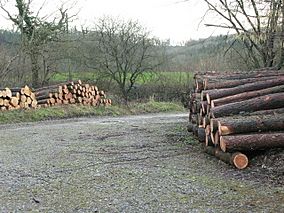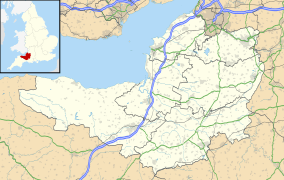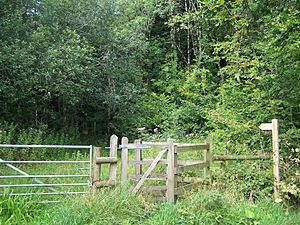Harridge Wood facts for kids
Quick facts for kids Harridge Wood |
|
|---|---|

Logs waiting collection near the entrance to the nature reserve
|
|
| Nearest city | Radstock, Somerset, England |
| Area | 55 hectares (140 acres) |
| Designation | Nature reserve |
| Administrator | Somerset Wildlife Trust |
Harridge Wood is a special forest area in Somerset, England. It's a place where nature and history meet!
Long ago, around the year 1300, people started digging for coal here. This mining went on for about 500 years, until the 1800s. Today, you can still see the old mining tunnels and pits, which are now a protected historical site.
Most of Harridge Wood is now part of the Harridge Woods Nature Reserve. While some parts of the wood were planted with trees for timber in the past, the reserve is now working hard to bring back the original plants and trees that used to grow there.
Contents
About the Wood's Environment
Harridge Wood sits on clay slopes with streams flowing through them. It's believed to be a very old forest. However, in the mid-1900s, many of the original broadleaf trees (trees that lose their leaves in autumn) were cut down. They were replaced with poplars and conifers (trees like pines and firs).
Luckily, some parts of the ancient forest still remain. You can find these older sections at the edges of the woodland and in wet areas. Here, you might see old hazel trees that were coppiced (cut back to the ground to grow many new stems). There are also "stoggles," which are low pollards (trees cut above the reach of grazing animals) of ash, oak, and alder.
The parts of the wood that haven't been disturbed much have a wide variety of plants. You'll find ferns in the wetter spots and different woodland herbs in the drier areas. Some nearby fields are used for cows, and these fields attract bats that like to hunt for food. Other bats fly along the woods and streams.
Old Coal Mines in the Wood
Harridge Wood and a nearby area called Edford Wood have many signs of coal mining from before the 1700s. This is because the coal seams (layers of coal) were close to the surface here.
These old mining areas in Harridge Wood and Edford Wood South are now a protected historical site. This means they are kept safe because they show how people mined coal a long time ago. The site covers about 16 hectares (that's like 40 football fields!). It includes parts of several villages in Somerset.
The old coal workings are very well preserved because they were left undisturbed within the forest. They show us the different ways miners dug for coal before the 1800s.
In the earliest days, miners used a method called bell pits. They would dig a narrow shaft straight down to the coal. Then, at the bottom, they would dig outwards in a circle, making the pit look like a bell. Once that area was mined, they would move to a new spot nearby and repeat the process. This way, they could get as much coal as possible.
In Harridge Wood East, 52 bell pits have been found! The biggest one is about 25 meters (82 feet) wide. Miners also dug adits, which are horizontal tunnels. These tunnels helped them reach the coal or drain water out of the mines. There were also leats, which were channels that carried water to power machinery or to drain water away. You can still see mounds of dug-out material and the remains of old shafts.
The coal mining here was active from around 1300 to 1800, though some small mining continued even longer.
Harridge Woods Nature Reserve
The Harridge Woods nature reserve is a large area of 55 hectares (about 136 acres). It is looked after by the Somerset Wildlife Trust.
The reserve is made up of five different sections: Home Wood, Limekiln Wood, Harridge Woods West, Harridge Woods East, and Edford Woods South. There are two nature trails you can follow, with signs that tell you interesting facts about the area. The Mells River flows through the western part of the reserve.
The woods are carefully managed, and some timber (wood for building) is still taken out. A group called the Cerberus Spelæological Society helps look after any caves or historical sites in the reserve.
Plants of the Reserve (Flora)
The trees you can find here include different kinds of alder, ash (Fraxinus excelsior), hazel (Corylus avellana), Norway Spruce (Picea abies), pedunculate oak (Quercus robur), silver birch (Betula pendula), spindle (Euonymus europaeus), and wych elm (Ulmus glabra).
You might also spot interesting fungi like fly agaric (Amanita muscaria), King Alfred's cake (Daldinia concentrica), and scarlet elf cup (Sarcoscypha coccinea).
Other plants growing in the reserve include bluebell (Hyacinthoides non-scripta), enchanter's nightshade (Circaea lutetiana), hart's tongue fern (Asplenium scolopendrium), lesser celandine (Ficaria verna), meadow saffron (Colchicum autumnale), nettle-leaved bellflower (Campanula trachelium), Solomon's seal (Polygonatum multiflorum), toothwort (Lathraea squamaria), wild garlic (Allium ursinum), wood anemone (Anemone nemorosa), and yellow archangel (Lamium galeobdolon).
Animals of the Reserve (Fauna)
An old, rundown cottage in the reserve has been fixed up to be a special home for bats!
The bats living here include the brown long-eared bat (Plecotus auritus), the greater horseshoe bat (Rhinolophus ferrumequinum), and the lesser horseshoe bat (Rhinolophus hipposideros).
Other animals you might find are the Eurasian otter (Lutra lutra), European badger (Meles meles), hazel dormouse (Muscardinus avellanarius), roe deer (Capreolus capreolus), and wood mouse (Apodemus sylvaticus).
Birds that call Harridge Wood home include the common kingfisher (Alcedo atthis), Eurasian bullfinch (Pyrrhula pyrrhula), European green woodpecker (Picus viridis), song thrush (Turdus philomelos), and white-throated dipper (Cinclus cinclus).
You might also see beautiful butterflies like the comma (Polygonia c-album) and the common brimstone (Gonepteryx rhamni).



